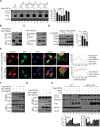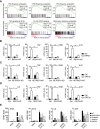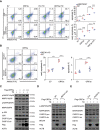SARS-CoV-2 ORF3a induces RETREG1/FAM134B-dependent reticulophagy and triggers sequential ER stress and inflammatory responses during SARS-CoV-2 infection
- PMID: 35239449
- PMCID: PMC9629087
- DOI: 10.1080/15548627.2022.2039992
SARS-CoV-2 ORF3a induces RETREG1/FAM134B-dependent reticulophagy and triggers sequential ER stress and inflammatory responses during SARS-CoV-2 infection
Abstract
SARS-CoV-2 infections have resulted in a very large number of severe cases of COVID-19 and deaths worldwide. However, knowledge of SARS-CoV-2 infection, pathogenesis and therapy remains limited, emphasizing the urgent need for fundamental studies and drug development. Studies have shown that induction of macroautophagy/autophagy and hijacking of the autophagic machinery are essential for the infection and replication of SARS-CoV-2; however, the mechanism of this manipulation and the function of autophagy during SARS-CoV-2 infection remain unclear. In the present study, we identified ORF3a as an inducer of autophagy (in particular reticulophagy) and revealed that ORF3a localizes to the ER and induces RETREG1/FAM134B-related reticulophagy through the HMGB1-BECN1 (beclin 1) pathway. As a consequence, ORF3a induces ER stress and inflammatory responses through reticulophagy and then sensitizes cells to the acquisition of an ER stress-related early apoptotic phenotype and facilitates SARS-CoV-2 infection, suggesting that SARS-CoV-2 ORF3a hijacks reticulophagy and then disrupts ER homeostasis to induce ER stress and inflammatory responses during SARS-CoV-2 infection. These findings reveal the sequential induction of reticulophagy, ER stress and acute inflammatory responses during SARS-CoV-2 infection and imply the therapeutic potential of reticulophagy and ER stress-related drugs for COVID-19.Abbreviations: CQ: chloroquine; DEGs: differentially expressed genes; ER: endoplasmic reticulum; GSEA: gene set enrichment analysis; HMGB1: high mobility group box 1; HMOX1: heme oxygenase 1; MERS-CoV: Middle East respiratory syndrome coronavirus; RETREG1/FAM134B: reticulophagy regulator 1; RTN4: reticulon 4; SARS-CoV-2: severe acute respiratory syndrome coronavirus 2; TN: tunicamycin.
Keywords: ER stress; ORF3a; SARS-CoV-2; inflammatory response; reticulophagy.
Conflict of interest statement
No potential conflict of interest was reported by the author(s).
Figures








Similar articles
-
Reticulophagy and viral infection.Autophagy. 2025 Jan;21(1):3-20. doi: 10.1080/15548627.2024.2414424. Epub 2024 Oct 23. Autophagy. 2025. PMID: 39394962 Free PMC article. Review.
-
USP20 deubiquitinates and stabilizes the reticulophagy receptor RETREG1/FAM134B to drive reticulophagy.Autophagy. 2024 Aug;20(8):1780-1797. doi: 10.1080/15548627.2024.2347103. Epub 2024 May 12. Autophagy. 2024. PMID: 38705724 Free PMC article.
-
The spatiotemporal control of ER membrane fragmentation during reticulophagy.Autophagy. 2024 Jan;20(1):210-211. doi: 10.1080/15548627.2023.2252723. Epub 2023 Aug 31. Autophagy. 2024. PMID: 37651691 Free PMC article.
-
ATF4 links ER stress with reticulophagy in glioblastoma cells.Autophagy. 2021 Sep;17(9):2432-2448. doi: 10.1080/15548627.2020.1827780. Epub 2020 Oct 28. Autophagy. 2021. PMID: 33111629 Free PMC article.
-
Regulation of autophagy by SARS-CoV-2: The multifunctional contributions of ORF3a.J Med Virol. 2023 Jul;95(7):e28959. doi: 10.1002/jmv.28959. J Med Virol. 2023. PMID: 37485696 Review.
Cited by
-
The role of cell death in SARS-CoV-2 infection.Signal Transduct Target Ther. 2023 Sep 20;8(1):357. doi: 10.1038/s41392-023-01580-8. Signal Transduct Target Ther. 2023. PMID: 37726282 Free PMC article. Review.
-
The comprehensive SARS-CoV-2 'hijackome' knowledge base.Cell Discov. 2024 Dec 9;10(1):125. doi: 10.1038/s41421-024-00748-y. Cell Discov. 2024. PMID: 39653747 Free PMC article.
-
Autophagy of the ER: the secretome finds the lysosome.FEBS J. 2023 Dec;290(24):5656-5673. doi: 10.1111/febs.16986. Epub 2023 Nov 3. FEBS J. 2023. PMID: 37920925 Free PMC article. Review.
-
Contribution to pathogenesis of accessory proteins of deadly human coronaviruses.Front Cell Infect Microbiol. 2023 May 1;13:1166839. doi: 10.3389/fcimb.2023.1166839. eCollection 2023. Front Cell Infect Microbiol. 2023. PMID: 37197199 Free PMC article. Review.
-
Some aspects of the life of SARS-CoV-2 ORF3a protein in mammalian cells.Heliyon. 2023 Aug 1;9(8):e18754. doi: 10.1016/j.heliyon.2023.e18754. eCollection 2023 Aug. Heliyon. 2023. PMID: 37609425 Free PMC article.
References
Publication types
MeSH terms
Substances
LinkOut - more resources
Full Text Sources
Other Literature Sources
Medical
Molecular Biology Databases
Research Materials
Miscellaneous
